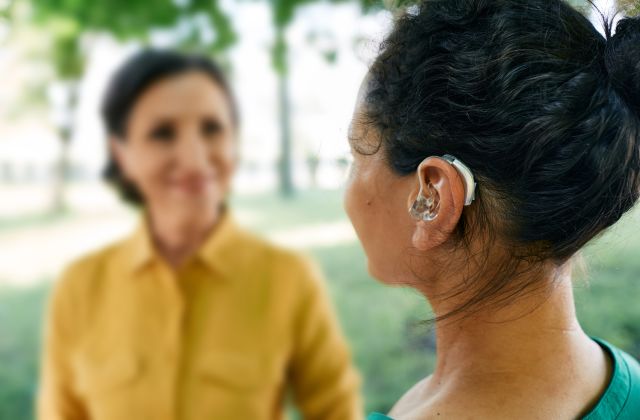Updated on September 13, 2024.
Is the volume on your TV creeping upward? Do you find yourself asking others to repeat themselves during conversations?
These are classic signs of hearing loss. If you’re experiencing them, you’re not alone: Roughly 15 percent of adults in the United States have some degree of hearing loss, according to the National Institute on Deafness and Other Communication Disorders (NIDCD). Nearly 29 million Americans would benefit from wearing hearing aids, the NIDCD notes. But only about one-fifth of those people actually get them.
In a move that could help address this issue, on September 12, the U.S. Food and Drug Administration (FDA) authorized the first over-the-counter (OTC) hearing aid software device, Hearing Aid Feature (HAF). The mobile medical application was designed for use with certain versions of Apple’s AirPods Pro. The HAF is set up using an iOS device, such as an iPhone or an iPad. Users can personalize the software and adjust tone and volume setting to their individual hearing levels on their own—without the help of a hearing professional.
“Hearing loss is a significant public health issue impacting millions of Americans,” said Michelle Tarver, M.D., Ph.D., acting director of the FDA's Center for Devices and Radiological Health. “Today’s marketing authorization of an over-the-counter hearing aid software on a widely used consumer audio product is another step that advances the availability, accessibility and acceptability of hearing support for adults with perceived mild to moderate hearing loss.”
Another longstanding barrier for many people is cost. But in 2022, the FDA created a new category of hearing aids that can be bought over-the-counter (OTC) at stores or online. Now, adults with mild-to-moderate hearing loss no longer need a prescription, medical exam, or fitting by a hearing specialist to buy hearing aids.
The decision makes hearing aids easier to buy and more affordable for millions of people. It could have a dramatic impact on the lives of those with hearing loss.
Some research suggests that people with hearing loss often wait up to 10 years before seeking medical help. Experts hope that eliminating purchase requirements and making it easier to get hearing aids will encourage more people to address hearing loss earlier on.
Reducing barriers for people with hearing loss
The way in which society is arranged can pose challenges for people with deafness or hearing loss. Some of these difficulties are obvious and others are more subtle.
For example, the way schools or workplaces are set up can make it difficult for people with deafness or hearing loss to communicate effectively with teachers, peers, and colleagues. This can make it hard to perform at a high level in these settings.
The general lack of use of American Sign Language (ASL) and assistive technologies can also make it difficult for people with deafness or hearing loss to communicate with others and to maintain relationships. Though hearing aids cannot solve all these problems, they may ease some difficulties.
Here’s what you should know about hearing aids, including who might benefit from them, which types are available, and how they work.
Who benefits from hearing aids?
“The majority of patients I see are older adults,” says Craig Hoekzema, MD, an ear, nose, and throat (ENT) specialist in Norton Shores, Michigan. But patients of all ages make their way to his practice.
Some people are born with hearing problems while others develop them. At every increased age bracket, the likelihood of hearing loss increases. For people 75 and over, for instance, there's a 50 percent chance of having hearing loss.
Hearing aids benefit people with sensorineural hearing loss, caused by damage to the inner ear, Dr. Hoekzema explains. This can happen due to wear and tear over time, he says. Diseases, ear injuries from loud noises, and some medications are also factors, according to the NIDCD.
Not all patients with hearing loss are the same, Hoekzema notes. If you start off without complete hearing clarity, a hearing aid will help turn up the volume, but will not necessarily restore fully sharp or clear sounds.
How do hearing aids work?
Hearing aids have several parts that work together to help amplify sound. These include a microphone, a processor, and a speaker. But hearing aid technology is more sophisticated than just amplification.
“Hearing aids are complex,” Hoekzema says. “And not all frequencies are treated identically.” Hearing aids are designed with the goal of increasing the volume of sounds you want to hear (like a friend’s voice) without amplifying noises you don’t need to hear (like the background noise at a restaurant).
Making sense of hearing aid options
There are a few different types of hearing aids available. These include:
Canal aids: These can be either completely-in-canal (CIC) or in-the-canal (ITC). If you choose a completely-in-canal hearing aid, it will be well-hidden so that other people probably won’t be able to see them. “It’s nearly invisible to the casual observer,” Hoekzema says. Both options are quite small and fitted to your ear. They’re best for people with mild to moderate hearing loss.
In-the-ear hearing aids: Sitting in the outer ear, these devices are bigger than canal hearing aids. They are typically used for people with mild to severe hearing loss.
Behind-the-ear: This may be what you picture when you imagine a hearing aid. There’s a small processor that sits behind your ear with clear tubing that goes into your ear, says Hoekzema. This hearing aid can help if you have mild to profound hearing loss.
Bone-anchored hearing aids: These are for a type of hearing loss called conductive hearing loss, in which sound waves can’t reach the inner ear. This type of hearing aid is surgically implanted into the bone behind your ear and it works by transmitting sound vibrations directly into the inner or middle ear.
Middle ear implant: This device attaches directly to the bones of the middle ear. Instead of amplifying sound that goes into the ear, a middle ear implant moves these bones to increase the strength of sound vibrations.
How can you know which hearing aid is right for you?
Your ENT specialist or an audiologist (a healthcare provider who specializes in hearing issues) can help you sort through the pros and cons of each type of device. For instance, while you may like the discreet look of CIC or ITC models, they can lead you to hear your voice in your head when you speak, Hoekzama says. They are also associated with feedback. Careful fitting and programming can usually eliminate this whistling noise.
Batteries are another factor to consider. Some hearing aids have rechargeable batteries, while others use small disposable batteries. For people with limited manual dexterity (difficulty using one’s fingers), changing tiny batteries may be a challenge. That may make rechargeable models a better bet.
How to shop for hearing aids
The process usually begins by visiting an ENT or an audiologist for an exam. During your visit, you can discuss the hearing aid options that may be right for you. Your healthcare provider (HCP) may also want to look for causes of hearing loss that may require treatment.
Patients may need to try a few options before determining which hearing aid makes the most sense, says Hoekzema. Your ear shape, level of hearing loss, and personal preferences should all be taken into account. While a medical exam or HCP visit is probably a good idea if you have any amount of hearing loss, people with mild to moderate hearing loss can skip that step and buy OTC hearing aids .
Once you do buy your hearing aids, you’ll likely need time to adjust to them. It can take a month or more to get comfortable with a new hearing aid, Hoekzema says. In many cases, hearing aids come with a trial period to help you make sure the ones you buy are right for you. Check to see if a trial period is available before buying.
Hearing aids can be a big purchase. OTC options may range in price from around $100 to $2,000 per pair. The cost of prescription hearing aids could range as high as $6,000, on average. High-end products can be even more expensive.
Unfortunately, hearing aids are often not covered by insurance. Original Medicare, for instance, only covers bone-anchored hearing aids because they are classified as a prosthetic. (Medicare Advantage may cover hearing aids, though it varies by plan.) Medicaid covers hearing aids for children but coverage varies by state for adults.
In some cases, the U.S. Department of Veterans Affairs (VA) will cover the cost of hearing aids for veterans. For instance, if you are a veteran with significant hearing loss linked to your military service or a medical condition treated at a VA hospital, you may be eligible to receive hearing aids through the VA. Federal employees and their families may also be entitled to basic hearing aids through some insurance plans. Some nonprofit organizations may also help cover the cost of hearing aids for people with limited incomes.
You may also be able to receive discounted or free hearing aids (along with other assistive devices to help you better manage your job) through a Vocational Rehabilitation (VR) program. Search for VR programs in your city or state to see if you may be eligible.
Keep in mind, if you have a medical flexible spending account (FSA) or a health savings account (HSA), these funds could be used to purchase hearing aids and batteries.
Life with hearing aids
The goal when using a hearing aid is to allow you to hear as well as you possibly can. But the overall benefit may be limited.
For people who experience hearing loss, “the tone and quality with hearing aids is a little bit different,” says Hoekzema. “Nothing is quite as good as the hearing you were born with.”
It can also take patients several months to adjust. When you first start wearing your hearing aids, you may hear overly loud background sounds or experience occlusion (the sound of your voice echoing in your head).
Be sure to mention any issues to your HCP or audiologist. Sometimes adjustments can help. That's particularly true for feedback, which is a fixable problem. If the tweaks do not help, it may be worth trying another type of hearing aid.
Hearing aids typically have a five- to six-year lifespan, Hoekzema says. How long they last will depend on which type you choose. “We typically see patients one or two times a year to clean their hearing aids, maybe do a quick hearing test and make any required adjustments,” he adds.
Don’t delay getting hearing aids
“Patients often wait too long to start wearing hearing aids,” Hoekzema cautions. “If you’re 95 years old and you’ve had hearing loss for 30 years and you’re just now starting to wear hearing aids, changes have happened in your brain in those hearing pathways that aren’t going to come back,” he says. In fact, even relatively mild levels of hearing loss can lead to changes in perception, comprehension, and memory.
In these cases, a person’s response to hearing aids will not be the same as for someone who began wearing them closer to the onset of their hearing loss, Hoekzema points out.
“I’ve become a bit more aggressive about suggesting hearing aids,” he adds, given research on the association between hearing loss and dementia.
If you’re unsure about hearing aids, go for an appointment to determine if a hearing aid is right for you. Or, if you have mild to moderate hearing loss, consider shopping for an OTC hearing aid. Addressing what may seem like a small problem today can provide a big benefit down the road.






